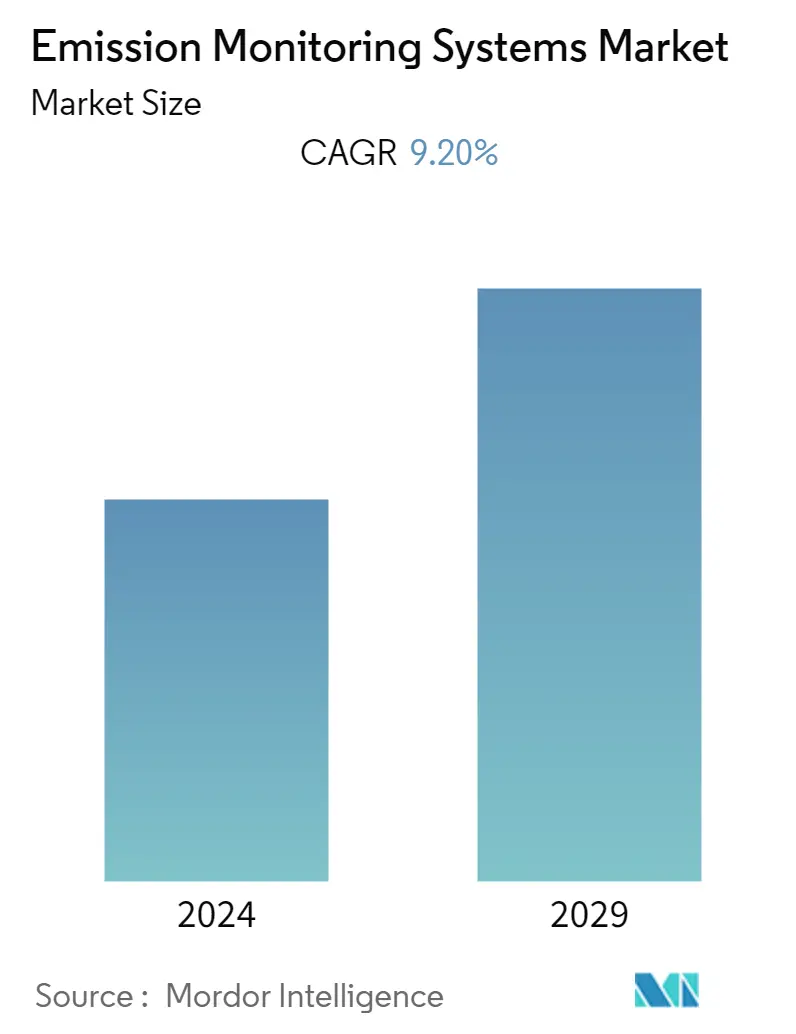Market Size of Emission Monitoring Systems Industry

| Study Period | 2019 - 2029 |
| Base Year For Estimation | 2023 |
| CAGR | 9.20 % |
| Fastest Growing Market | Asia Pacific |
| Largest Market | North America |
| Market Concentration | Medium |
Major Players
*Disclaimer: Major Players sorted in no particular order |
Need a report that reflects how COVID-19 has impacted this market and its growth?
Emission Monitoring Systems Market Analysis
The Emission Monitoring Systems Market is expected to grow at a CAGR of 9.2% during the forecast period. The major factors driving the growth of the market include stringent legal and environmental regulations made by governments across the globe, increasing health and safety issues, increasing awareness about environmental protection, and growing usage of oil & gas and petrochemicals.
- The emission monitoring system measures various gases in the air, such as carbon dioxide, nitrogen, mercury, sulfur dioxide, carbon monoxide, and hexavalent chromium. In the continuous type system, the analyzer is primarily used to measure the gases emitted, whereas the software component enables the users to evaluate the results of the applicable emission. The predictive type system uses modeling software to calculate the emission rate, which is based on the control device operating parameters and enables the user to predict the emission levels.
- Using these emission monitoring systems to comply with the emission standards created by the government is one of the major considerations from the market growth perspective. For instance, the United States Environmental Protection Agency has rolled out multiple federal programs to monitor emissions in the region. Moreover, state authorities' continuous collection of emission data has thrust the market.
- Various governments adopt regulations to control industrial activity emissions, boosting the market. For instance, the Department of Environment, Malaysia, deployed the Environmental Quality Act 1974 and Clean Air Regulation 2014, which has Regulation 7 Air Pollution Control System and Regulation 9 - Performance Monitoring of Air Pollution Control System, to control air pollution. All these factors are forcing the government to use emissions monitoring systems.
- With the recent COVID-19 outbreak, the emissions monitoring systems are playing a crucial role in monitoring the air quality and providing necessary information during this pandemic, as COVID-19 is an infectious respiratory disease, and air quality affects respiratory health. On April 22, 2020, the data analytics company, EMSOL, announced working with Network Rail to monitor air quality in train stations and implement a strategy to lower the pollution around them. The project mostly benefits patients recovering from COVID-19 and people with respiratory issues exposed to poor air quality in busy areas.
- During the forecast period, the growing emphasis on clean energy is expected to hinder the growth of the global emission monitoring system market. Renewable energy has grown in popularity since the beginning of the century. Many countries are making significant efforts to produce renewable energy sources that are sustainable, reliable, and efficient, such as solar power, wind power, and bioenergy. These energy sources are assumed to replace existing conventional energy sources. As a result, to reduce CO2 emissions, the world must rapidly transition to a low-carbon energy source. As a result, an emission monitoring system is no longer required.
